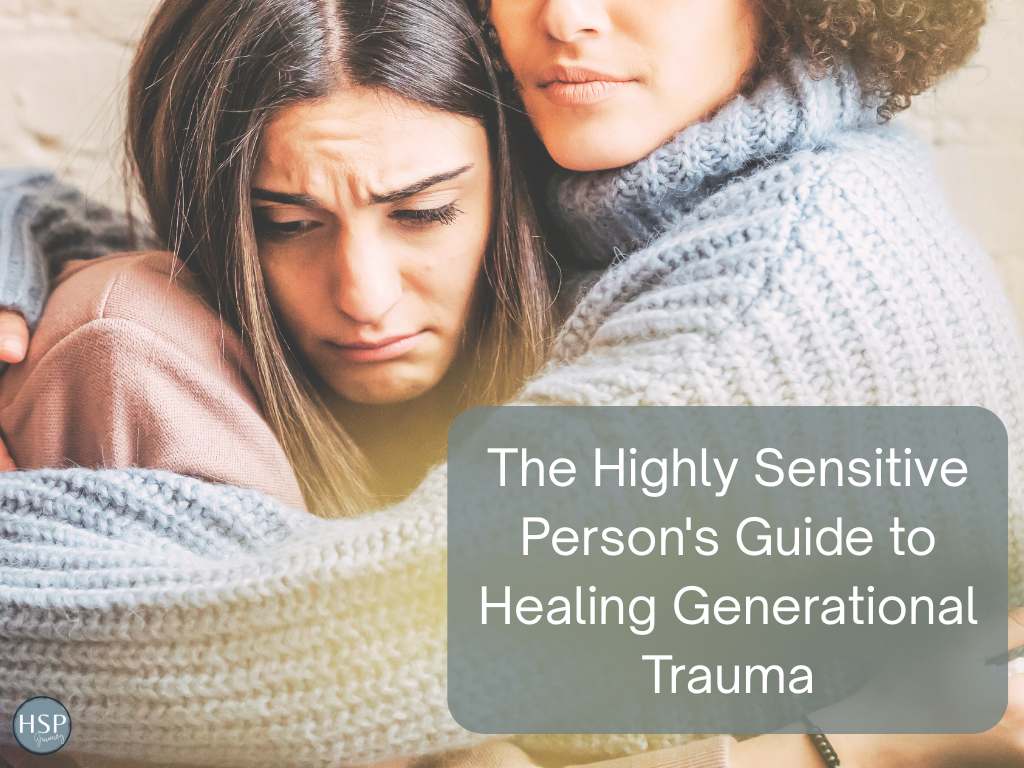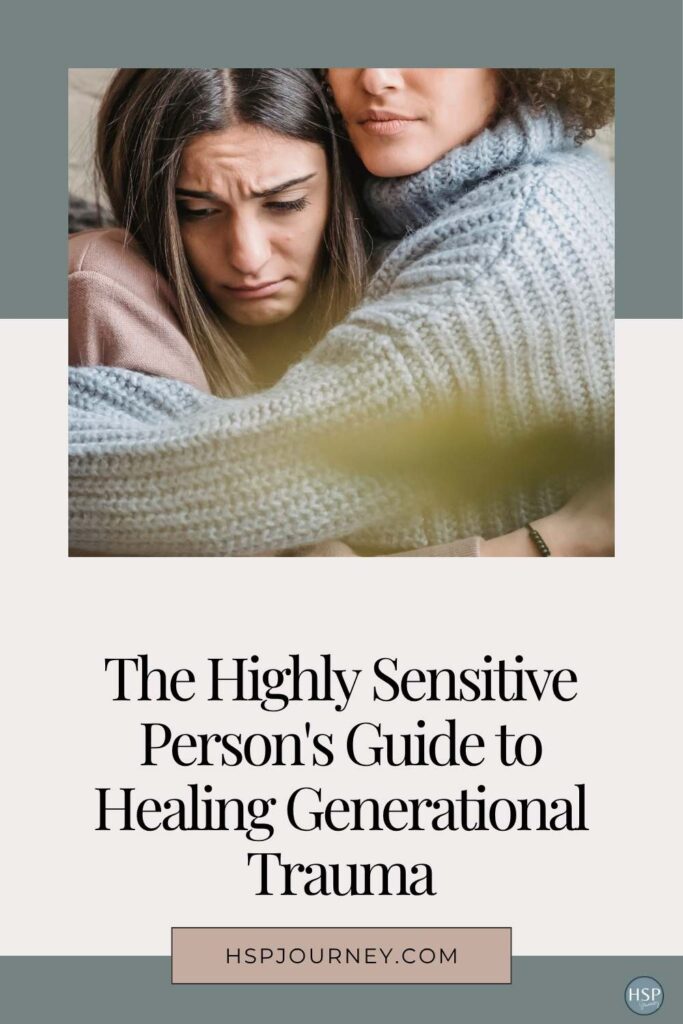As highly sensitive people (HSPs), we experience the world more intensely, processing information deeply and sensing subtle nuances that others might miss. This heightened awareness extends to how we experience trauma, both our own and that which has been passed down through our family lines. For HSPs, our innate depth of processing means generational trauma can impact us in profound ways, often manifesting as overwhelming emotions, persistent anxiety, or an inexplicable sense of carrying burdens that don’t seem entirely our own.
Generational trauma, patterns of emotional, behavioral, and neurological responses transmitted across multiple generations, can be especially challenging for highly sensitive individuals. Yet our sensitivity, when properly channeled, can become our greatest asset in the healing journey. This guide explores how HSPs can recognize, understand, and begin to heal generational trauma, transforming pain into purpose and inherited wounds into wisdom.

Table of Contents
Understanding Generational Trauma as an HSP
Generational trauma isn’t just about significant historical events or obvious family dysfunction. For HSPs, it often manifests in subtler ways—through unspoken family rules, emotional patterns, or even energetic imprints that we inherently pick up on due to our heightened sensitivity.
Most childhood trauma isn’t about what happened to you. It’s about what didn’t happen for you. For highly sensitive people, this rings especially true. The absence of validation, space for our emotions, or recognition of our unique sensory needs can create wounds that continue through generations.
As HSPs, we may have inherited:
- Patterns of emotional suppression (“don’t feel so much”)
- Hypervigilance and anxiety responses
- Difficulty with boundaries and self-advocacy
- Shame around sensitivity or emotional expression
- Unique sensory sensitivities that were never accommodated
Many HSPs discover that what they assumed were simply personality traits are adaptive responses to generational wounds. The tendency to people-please, perfectionism, chronic overwhelm, or difficulty trusting your intuition often has roots in how sensitivity was treated in your family system.
How HSPs Experience Ancestral Wounds Differently
Our heightened nervous systems process information differently, including traumatic imprints. As Dr. Elaine Aron’s research shows, HSPs have more active mirror neurons, which leads to greater empathy and emotional responses. This means we may:
- Feel ancestral emotions more intensely
- Pick up on unspoken family dynamics with greater clarity
- Experience stronger physical and emotional reactions to trauma triggers
- Process traumatic memories with more vivid detail and nuance
- Intuitively sense what couldn’t be verbally expressed in previous generations
These differences are neither good nor bad—they simply represent our unique way of processing. Understanding this can help release self-judgment and recognize that what you’re experiencing makes perfect sense given your sensitivity trait.
The HSP Advantage in Trauma Healing for Generational Trauma
While being highly sensitive can make trauma more impactful, it also offers unique advantages for healing:
- Depth of Processing: HSPs naturally process experiences deeply, allowing for more thorough integration of healing work.
- Emotional Awareness: Your ability to attune to subtle emotional states helps you identify trauma responses as they arise.
- Sensing the Subtle: Highly Sensitive People (HSPs) often notice slight shifts in energy and emotional states that others might miss, providing valuable feedback during the healing process.
- Intuitive Connection: Many HSPs report stronger intuitive connections with their ancestors and family patterns, which helps them identify what needs healing.
- Empathic Understanding: Your natural empathy extends to your ancestors, allowing you to feel compassion for their challenges and choices.
As one HSP trauma survivor shared, “My sensitivity allowed me to feel the pain more deeply, but it also meant I could feel the healing more completely. The same trait that made trauma overwhelming became my greatest asset in recovery.”
Five Steps to Begin Your Healing Journey from Generational Trauma
1. Create Safety for Your Sensitive System
Before diving into trauma work, establishing safety for your nervous system is essential. For HSPs, this means:
- Creating environments that honor your sensory needs
- Setting boundaries around exposure to triggering content or conversations
- Developing a daily practice that regulates your nervous system
- Finding practitioners who understand and respect high sensitivity
Remember: healing happens within a window of tolerance where you feel both activated and safe. As an HSP, your window may be narrower than others’, so you may need to pace more intentionally.
2. Map Your Family Patterns with Sensitivity
HSPs excel at pattern recognition. Use this strength to map your family system:
- Notice emotional patterns that repeat across generations
- Identify “family rules” about emotions, needs, and self-expression
- Recognize how sensitivity has been treated in your lineage
- Look for correlations between family history and your current challenges
This mapping process isn’t about blaming but understanding the context of your experience. Generational trauma is passed down through observed behaviors, unconscious beliefs, energetic patterns, and even in-utero experiences.

3. Reconnect with Your HSP Inner Child
Many HSPs didn’t receive what they needed as sensitive children. As Lauren notes in her “5 Things You Probably Didn’t Get as a Highly Sensitive Child” article, many HSPs grew up without enough sensitivity to their general personality and need for pacing.
Healing requires reconnecting with this inner child:
- Validate the experiences your sensitive child self had
- Acknowledge what you needed but didn’t receive
- Create space for emotions that weren’t allowed
- Offer your inner child the understanding that may have been missing
This reconnection process is potent for HSPs because our depth of emotional processing allows us to create genuine internal change through this relationship.
4. Develop HSP-Friendly Regulation Tools
Trauma healing requires tools that work with your sensitive nervous system, not against it. Practical approaches for HSPs include:
- Breathwork: Conscious connected breathing practices help regulate the nervous system without overwhelming it with sensory input.
- Somatic Techniques: Gentle movement practices that help process trauma stored in the body while honoring sensory sensitivities.
- Nature Connection: Many HSPs find robust regulation through time in natural settings that offer both stimulation and calm.
- Creative Expression: Artistic practices that externalize internal experiences without requiring verbal processing.
The key is finding approaches that respect your sensory thresholds while supporting release and integration.

Looking for an HSP-Trained coach to help you align your life with your priorities?
Through my Highly Sensitive Person (HSP) certification with the Nickerson Institute, as well as being an HSP, I offer HSP coaching to develop specific goals around your HSP needs. We HSPs frequently deal with anxiety and overstimulated nervous systems that prevent us from achieving peace and attaining our life goals. HSP coaching with me includes a detailed review of your sensitivities and a mutually-desired plan for growth and management of this superpower to shift negativity and begin seeing yourself as the hero of your own story.
5. Integrate Healing Across Mind, Body, and Energy
For HSPs, effective trauma healing addresses all dimensions of experience. For HSPs, effective trauma healing addresses all dimensions of experience. In my work, I’ve found that proper integration happens when we work with:
- Mind: Understanding patterns and creating new narratives
- Body: Releasing stored trauma responses from the physical system
- Energy: Addressing the subtle energetic imprints of generational patterns
This multi-dimensional approach is particularly practical for HSPs, who naturally perceive across these different levels of experience.
Creating a Nervous System-Friendly Approach
For HSPs, conventional approaches to trauma healing can sometimes be overwhelming. Creating a nervous system-friendly approach means:
- Pacing: Moving slower than you think necessary, allowing full integration
- Titration: Working with small amounts of traumatic material at a time
- Resource-Building: Strengthening resilience before diving into challenging material
- Pendulation: Alternating between addressing trauma and connecting with positive resources
As Anita Kaiser notes in her work on the HSP nervous system, “Learning to love yourself and your sensitive nature will be an incredible gift.” This self-compassionate approach is fundamental to trauma healing that works with your sensitivity rather than against it.
Looking for HSP Tools to Thrive in a Chaotic World?
The modern world is often overwhelming and stressful for those of us with sensitive nervous systems. Many of us have suffered from the challenges of high stress, anxiety, sensory overload, and mental health and physical health issues. Fortunately, after years of working with and researching Highly Sensitive People (HSPs), Julie Bjelland has developed many tools that have not only helped her but thousands of HSPs all over the world move out of survival mode living and into thriving. In this free webinar, she’ll share the tools that HSPs have found the most life-changing. Her goal is to help you live to your fullest potential because the world needs you.
Join this free webinar and get tools to help you thrive as an HSP!
When to Seek Professional Support for Generational Trauma
While self-guided healing can be powerful, professional support is often essential for addressing generational trauma. Signs it’s time to seek help include:
- Feeling persistently overwhelmed by emotions
- Experiencing intrusive memories or flashbacks
- Finding that trauma responses significantly impact daily functioning
- Having difficulty maintaining healthy boundaries
- Noticing unhealthy patterns repeating despite your awareness
When seeking professional help, look for practitioners who:
- Understand the highly sensitive trait
- Work with nervous system regulation
- Address trauma through multiple modalities
- Respect your sensory needs and pace
- Create safety for your sensitive system
Embracing Your Sensitivity as a Healing Gift
As you move through your healing journey, remember that your sensitivity isn’t an obstacle to overcome but a gift to embrace. The same traits that make you more vulnerable to the impacts of generational trauma—your depth of processing, emotional responsiveness, and intuitive awareness—are powerful assets in the healing process.
When channeled with intention, your highly sensitive nature becomes a bridge not only to your healing but also potentially to healing across generations. Many HSPs discover that as they heal their trauma, they become intuitive guides for others navigating similar terrain.
In the words of one HSP who has walked this path: “Healing my generational trauma didn’t diminish my sensitivity—it liberated it. What once felt like a burden became my greatest strength, allowing me to sense possibilities for healing and growth that I couldn’t have imagined before.”
Your sensitivity is not the problem; it’s an essential part of the solution. By honoring this trait while addressing generational patterns, you create the possibility of transformation that extends beyond your individual experience to touch your entire family system—past, present, and future.
Remember that healing is not linear, and as an HSP, your path may look different from others’. Honor your unique journey, trust your sensitive intuition, and know that your healing creates ripples that extend far beyond your individual experience./
Be sensitive, be free
*This post contains affiliate links and I will be compensated if you make a purchase after clicking on my links*





[…] kids are incredibly outgoing while others are terrified of large groups. As with a vast variety of childhood experiences, each child is unique and created by God to be a special, wonderful individual. […]